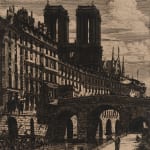Open a larger version of the following image in a popup:
 Sold to the Milwaukee Art Museum
Sold to the Milwaukee Art Museum
 Sold to the Milwaukee Art Museum
Sold to the Milwaukee Art Museum
Open a larger version of the following image in a popup:
 Sold to the Milwaukee Art Museum
Sold to the Milwaukee Art Museum
 Sold to the Milwaukee Art Museum
Sold to the Milwaukee Art Museum
Charles Meryon (1821-1868)
The Petit Pont, Paris, 1850
Etching and burin on Japanese paper
260 x 189 mm. (10 ¼ x 7 7/16 inches)
Annotated in pen and black ink: “les tours Notre dame et l’hotel dieu démoli 1854”
Delteil/Wright 24 third state (of six); Schneidermann 20 fourth state (of nine)
Sold
A sublime, inky and richly differentiated early impression on golden-toned Japanese Gampi paper. The silky structure of this fine-grained paper completely absorbs the printing ink and creates deep black, velvety...
A sublime, inky and richly differentiated early impression on golden-toned Japanese Gampi paper. The silky structure of this fine-grained paper completely absorbs the printing ink and creates deep black, velvety transitions. With the delicate drypoint reworking of the sky and in the large cloud on the left, which are no longer visible in the subsequent states; with several needle scratches in the empty lower text margin, before numerous other reworkings. Minor defects, otherwise in perfect condition. The etching Le Petit Pont is without doubt one of the most significant and expressive of Charles Meryon’s creations. The artist began work on it around 1850 and took painstaking care with its completion in the following years, confirmation of which is furnished by the relatively large number of different printing states.
Several preliminary drawn studies have survived – a further indication of Meryon’s meticulousness. Le Petit Pont is his first effort at creative printmaking of his own. He had begun by making copies of etchings by 17th century Dutch masters in order to hone his technical skills. The etching is the perfect embodiment of Meryon’s artistic objectives and, given the early stage at which the artist produced it, is remarkable for its technical virtuosity. The two massive Gothic bell towers of Nôtre-Dame Cathedral rise up darkly in the background, but Meryon nonetheless manages to convincingly capture their filigree structure. Using a detailed, intricate etching style and with the help of narrow, richly differentiated hatching patterns, he reproduces the flickering light on the weathered walls of the Hôtel de Dieu. The dramatically heightened chiaroscuro effect enhances the romantic mood of this atmospheric and extremely suggestive scene. This is the dark, threatening, medieval Paris of Victor Hugo, and Meryon emerges as a brilliant interpreter of his spiritual world.
Several preliminary drawn studies have survived – a further indication of Meryon’s meticulousness. Le Petit Pont is his first effort at creative printmaking of his own. He had begun by making copies of etchings by 17th century Dutch masters in order to hone his technical skills. The etching is the perfect embodiment of Meryon’s artistic objectives and, given the early stage at which the artist produced it, is remarkable for its technical virtuosity. The two massive Gothic bell towers of Nôtre-Dame Cathedral rise up darkly in the background, but Meryon nonetheless manages to convincingly capture their filigree structure. Using a detailed, intricate etching style and with the help of narrow, richly differentiated hatching patterns, he reproduces the flickering light on the weathered walls of the Hôtel de Dieu. The dramatically heightened chiaroscuro effect enhances the romantic mood of this atmospheric and extremely suggestive scene. This is the dark, threatening, medieval Paris of Victor Hugo, and Meryon emerges as a brilliant interpreter of his spiritual world.
Provenance
Jules Gerbeau, Paris [Lugt 1166, this impression mentioned]
Maurice Gobin, Paris [Lugt 1124 a]

